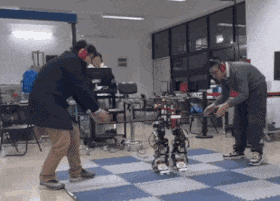Chinese engineers have taught a two-legged robot Jet-HR2 to rise into the air and hover in one place using fans in the feet. A recording of the tests was published on the laboratory's YouTube channel.
Humanoid and other walking robots are considered the most passable type of robots, which, for example, has been demonstrated by Boston Dynamics with its Atlas for several years. But their possibilities are not infinite either — they are at least limited by the length and height of the step. Separate groups of engineers are working on creating bipedal robots capable of flying over obstacles if necessary and returning back to energy-efficient walking. In particular, engineers from the Guangdong Institute of Technology are doing this. Initially, they created a two-legged robot Jet-HR1, which could only step through the openings, supporting the leg in the air with fans, and then began to teach him exactly full flight.
Externally, the robot is two legs connected from above, but without a trunk. The robot has four fans: one at the feet and two more at the waist level. In the summer of 2021, the developers showed for the first time how it lifts off from the ground, but at that time it used simple thrust control algorithms, which were not enough for normal flight. Because of this, the robot could not hang in one place and had to be held with his hands.
In the new video, engineers demonstrated progress in the development of a flight control algorithm — now the robot is able to take off and hang in one place.
Despite the fact that when hovering above the floor, the robot shifts slightly in one direction or another, in general, the flight can be called stable. The developers showed two successful tests in which the robot hung in the air for about 25 seconds, and one unsuccessful one, in which the thrust was too high and it flew almost to the ceiling, after which its engines had to be turned off. One of the engineers managed to catch the falling robot and it, apparently, was not damaged.
At the end of last year, another group of engineers showed a controlled flight of a two-legged robot, during which it flew around the stairs and moved back to a step. Also, a two-legged flying robot has been created at the Italian Institute of Technology for several years. Unlike its two analogues, it is equipped not with electric motors with screws, but with jet engines in its hands. The developers of this project have already assembled a robot and tested it on the ground, but have not yet demonstrated takeoff.
Grigory Kopiev

